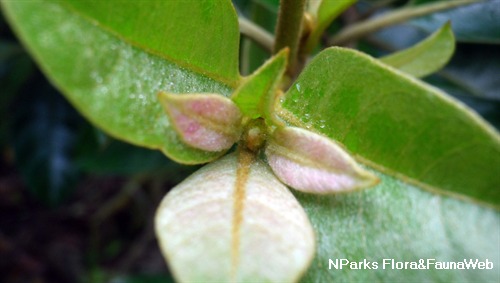
Name
Classifications and Characteristics
| Plant Division | Angiosperms (Flowering Seed Plants) |
|---|---|
| Plant Growth Form | Shrub, Tree |
| Lifespan (in Singapore) | Perennial |
| Mode of Nutrition | Autotrophic |
Biogeography
| Native Distribution | Southern Mexico, Peru, Brazil, Caribbean Islands |
|---|---|
| Native Habitat | Terrestrial |
| Preferred Climate Zone | Tropical, Sub-Tropical / Monsoonal |
Description and Ethnobotany
| Growth Form | Large shrub or tree to 10m tall, occasionally to 20m in height. |
|---|---|
| Foliage | Leaves 3-17cm long by 4-7cm wide; upper surface of leaves glossy, under surface brown-gray wooly tomentose. Young branches covered with a layer of brown hairs. |
| Flowers | Flowers bright yellow, turning orange red with age. |
| Fruit | Fruits 8-12cm in diameter, ripening yellow. |
| Ethnobotanical Uses | Edible Plant Parts : Edible Fruits Medicinal: An infusion of the bark is taken as a remedy for fevers and diarrhoea, and also to treat pulmonary complaints. A poultice made from the bark is applied on wounds and ulcers to promote healing. Others: A dye is extracted from the unripe fruits, which gives a brown hue to cotton. The bark is used in tanning to give leather a light yellow tone. The wood is used to make furniture and other small items for daily usage. The fresh branches, pounded or cut, are also used by locals to stupefy fish. |
Landscaping Features
| Desirable Plant Features | Ornamental Flowers, Ornamental Foliage, Ornamental Form |
|---|---|
| Landscape Uses | Parks & Gardens, Small Gardens |
| Thematic Landscaping | Golden Garden |
Fauna, Pollination and Dispersal
| Pollination Method(s) | Biotic (Fauna) (Insects (Bee), Insects (Ant, Beetle, Fly, Thrip, Wasp)) |
|---|---|
| Seed or Spore Dispersal | Biotic (Fauna) |
Plant Care and Propagation
| Light Preference | Full Sun, Semi-Shade |
|---|---|
| Water Preference | Moderate Water, Little Water |
| Rootzone Tolerance | Drought Tolerant, Well-Drained Soils, Poor Infertile Soils, Alkaline high pH Soils, Easy to Grow |
| Planting Remarks | Grows best in alkaline, sandy soils. |
| Pest(s) | Chewing Insects, Sucking Insects |
| Propagation Method | Seed, Stem Cutting, Marcotting |
Fruit, Seed and Spore
| Mature Fruit Colour(s) | Yellow / Golden |
|---|
Image Repository
Others
| Master ID | 29333 |
|---|---|
| Species ID | 3642 |
| Flora Disclaimer | The information in this website has been compiled from reliable sources, such as reference works on medicinal plants. It is not a substitute for medical advice or treatment and NParks does not purport to provide any medical advice. Readers should always consult his/her physician before using or consuming a plant for medicinal purposes. |













_lowres.jpg)
_lowres.jpg)